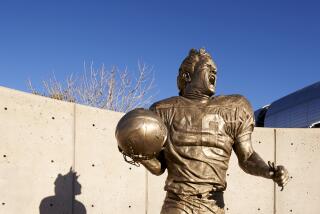George T. Sakato dies at 94; Japanese American WWII Medal of Honor recipient

George Sakato, right, takes part in a wreath ceremony for Asian American, Native American and Pacific Islander Medal of Honor recipients in 2000. With him are Army Maj. Gen. Robert R. Ivany, left, and fellow recipient Rudolph Davila.
“Roly-poly” is how George T. Sakato described his teenage self. To hear him tell it, he was almost a parody of a heroic figure — small, round and none too fit.
He was slimmer by the time he joined the Army but still so short that he had to march double-time to keep up.
He had brio. He was funny — he got in trouble for jokes he cracked at his superiors’ expense — and he had volunteered for service during one of the bloodiest periods of World War ll. But he was too puny even to carry his own gear. When they marched uphill, buddies carried his pack for him. Even so “I’m always the last one up that hill,” he said.
Six decades later, Sakato still appeared bewildered that his combat days ended as they did, with his belated receipt of the Medal of Honor for his actions in France in 1944. He received it, for, of all things, climbing a hill.
“How I got the medal, I don’t know,” Sakato said in an interview with PBS. “Others deserve this much more.”
Sakato, a private in Company E, Third Platoon, 442nd Regimental Combat Team — a segregated Japanese American unit — died Wednesday in Denver. He was 94.
He had earlier been awarded the Distinguished Service Cross for his actions on Oct. 29, 1944. But 55 years later, he got a call from a general inviting him to Washington.
The general said his cross would be upgraded to the Medal of Honor, the military’s highest honor, and he would receive it with nearly two dozen other Japanese American serviceman — including U.S. Sen. Daniel Inouye of Hawaii.
“Dad didn’t respond,” recalled his daughter, Leslie Sakato. “The general said, ‘Are you there? Are you there? Are you OK?’”
Sakato traveled to the White House in 2000. The ceremony there capped efforts to highlight the wartime heroism of Japanese American soldiers who advocates argued had previously been overlooked.
Sakato returned to Washington again in 2010 when his Nisei unit and two others received the Congressional Gold Medal.
George “Joe” Taro Sakato was born Feb. 19, 1921, in Colton, the son of Hatsu and Yoshitaka Sakato, who were born near Hiroshima, Japan, Sakato’s daughter said.
The elder Sakato came to California to work on railroads, then opened a barbershop, bathhouse and pool hall with his wife. George Sakato was one of seven children. He graduated from Redlands High School.
After the attack on Pearl Harbor, the family fled to Phoenix to avoid internment. Sakato was never put in a camp, but he delivered groceries to one and decades later recalled its towers and armed guards.
By 1944, the 442nd Regimental Combat Team and the 100th Infantry Battalion had been formed — both units manned with Nisei soldiers and sent to fight in mountainous territory in France.
Battling their way north, these soldiers met some of the fiercest fighting of the war, said Peter Wakamatsu of Lancaster, son of a 442nd veteran and independent researcher of the period.
“They were on the line for about a month,” he said. “By the time the battle ended, they had lost half their men. A lot to trench foot and illness, but also battle casualties.”
Theirs would become the most decorated regimental combat unit of the war.
Outside the town of Biffontaine, Sakato and his fellow soldiers surprised German troops from the back of a ridge. They chased them off the hill and took prisoners, but the Germans counterattacked. Sakato flung himself into one of their abandoned foxholes, with weapons he had found. There was a lull. A friend stood up for a better view and was hit.
“He was gurgling and his body went limp on me and he died. I sat there and held him. Why?” Sakato recalled. Five decades later he wept as if his friend’s corpse was still before him.
Sakato then rushed up the hill — a one-man assault. “Where I got the energy to run that hill ...,” he said later, trailing off. “I could never climb a hill before.” He spoke as if talking of someone else.
His citation says he galvanized his comrades and took charge after his squad leader was killed, using an enemy rifle and a pistol to repel an attack. He killed 12 German soldiers and took four prisoners. In total, the unit took 34 prisoners that day.
In interviews Sakato twinkled with humor about many aspects of his military service. But his face fell when he discussed his heroic battle. He told reporters of dead comrades. He talked of hearing the cries of an injured German soldier.
In one post-medal interview, he described poking the ground before his face with a bayonet. He was inching forward on his belly, hoping a land mine wouldn’t explode in his face. Almost six decades later, his breath grew short at the memory.
He was wounded in a subsequent action. Back home, he joined a friend in Denver and went dancing. He met Bessie “Bess” Sachiko Saito, and the two were married.
He went to work as a clerk for the U.S. Postal Service, and she in a print shop.
The two were married nearly 60 years, their daughter said. They were first-rate ballroom dancers who “would float across the floor,” she said.
His wife preceded him in death.
Sakato took an interest in veteran’s issues in Denver. He spoke to schools, supported memorials and participated in oral history projects. He talked of how, as a Nisei soldier, he had wanted to show his loyalty. He fished, golfed and played poker.
He never quite lost his tendency to downplay the high honor he’d received. “I couldn’t believe they were going to give me the Medal of Honor. I was just a recruit. Just a raw private!”
Besides his daughter, he is survived by brothers John Sakato of Agua Dulce and James Sakato of Los Angeles.
More to Read
Start your day right
Sign up for Essential California for the L.A. Times biggest news, features and recommendations in your inbox six days a week.
You may occasionally receive promotional content from the Los Angeles Times.






